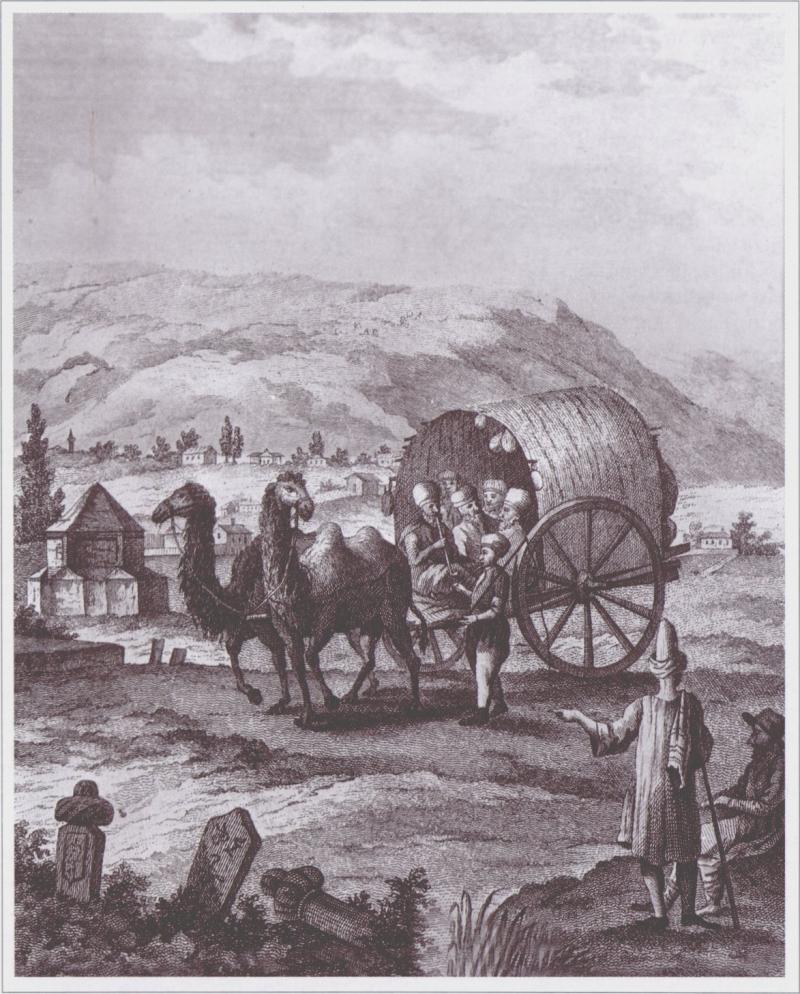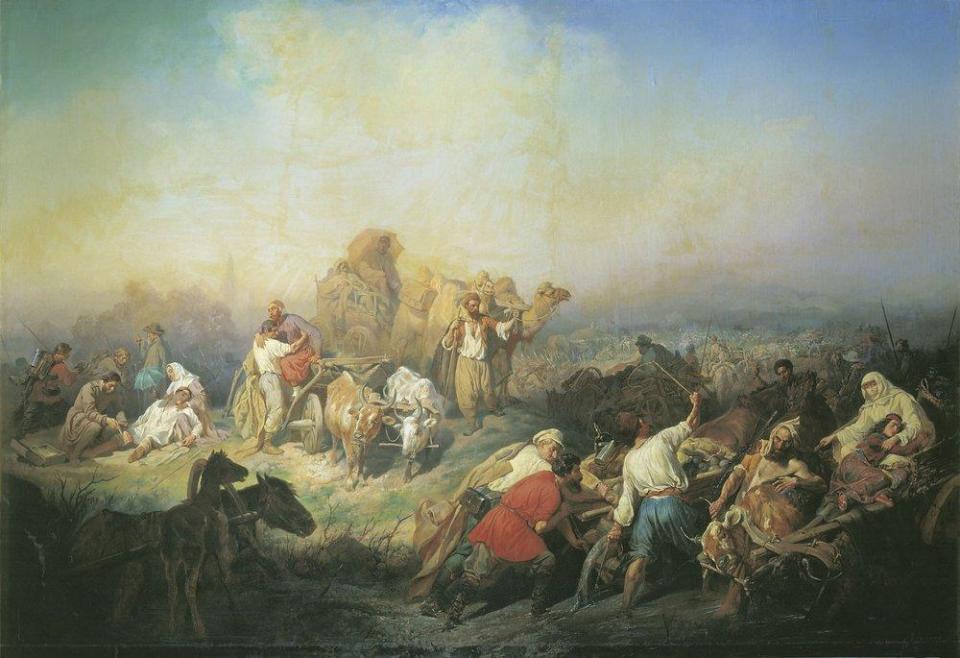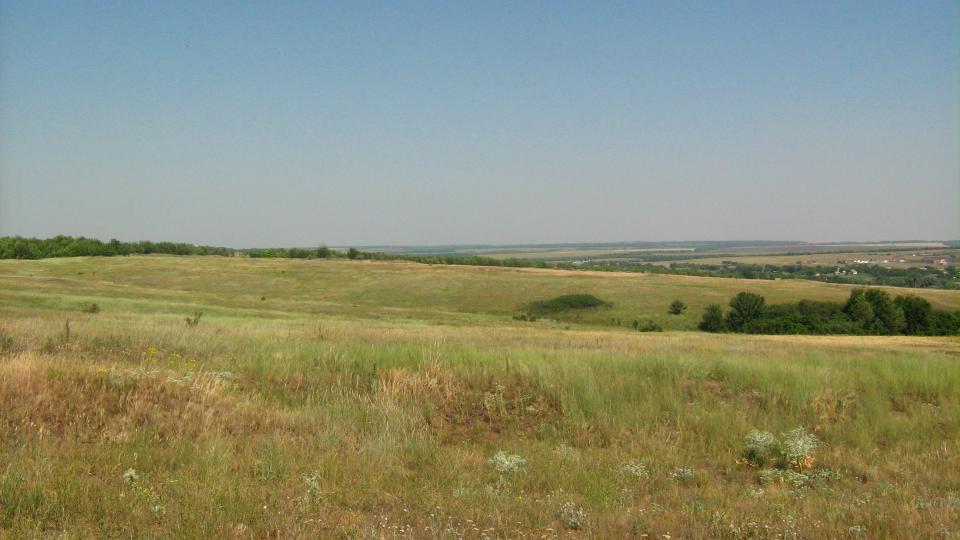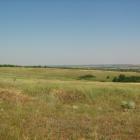Camels and Ukraine, a country located in Europe, seem to be mutually exclusive. Now this is really so. But just a century or two ago camels roamed the steppes of modern Southern Ukraine.
Camels occupied an essential place in the economic system of the Muslim Tatars of the Crimean peninsula and Northern Black Sea region, which they had supposedly taken over from the nomads – Cumans and Turkic peoples – of the Golden Horde. Natural conditions of the steppe zone, such as the semi-arid climate, low rainfall, low-density river system, and treeless grasslands, as well as cultural aspects such as the nomadic way of life and the respect for camels preached by Islam, contributed to the spread of the use of camels on the new lands.

Tatar’s cart harnessed by camels
Tatar’s cart harnessed by camels
Author: A. De Paldo
Original name: Cart named arba
Published in: Досуги крымского судьи или второе путешествие в Тавриду Павла Сумарокова. – Ч. 1. – Санкт-Петербург, 1803. – 235 (Dosug krymskogo sudi ili vtoroe puteshestvie v Tavridu Pavla Sumarokova. – Ch.1. – Saint Petersburg, 1803. – 235)
 This work is licensed under a Creative Commons Public Domain Mark 1.0 License.
This work is licensed under a Creative Commons Public Domain Mark 1.0 License.
As mentioned in the travel notes and diaries of travelers who made journeys to the Northern Black Sea and Crimea between the sixteenth and nineteenth centuries, camels became popular for cartage transport, freight haulage, passenger transportation, and riding. Moreover, camels were a source of milk and meat for the local population. Camel leather and wool were used to build homes and to weave clothes.
Camels occupied a significant place not only in Tatar economy, but also in their culture, as shown, for example, by lithographs depicting camel races or Tatar wedding processions with grooms on camels.
It is noteworthy that even after the Northern Black Sea region and Crimea became part of the Russian Empire at the end of the eighteenth century as a consequence of the Russo-Turkish War of 1768–1774, camels continued to play a pivotal role in the life of the steppe population. Despite the attempts at unification and standardization of all spheres of life in the new imperial territories, the regional authority borrowed some economic traditions from the Crimean Tatars, including the use of camels. This was due to both the need to facilitate the painless integration of the local people and the peculiar natural conditions of the new lands that were uncharacteristic for the Russian Empire.

The use of camels in military times
The use of camels in military times
Author: Konstantin Philippov
Original name: Военная дорога между Севастополем и Симферополем во время Крымской войны. 1858 (“Military road between Sevastopol and Simferopol during Crimean War. 1858”)
Place of preservation: The State Tretyakov Gallery
Click here to view Wikimedia source.
 This work is licensed under a Creative Commons Public Domain Mark 1.0 License.
This work is licensed under a Creative Commons Public Domain Mark 1.0 License.
Different scholars who explored the potential of the annexed territories noted that camels could be used in wartime. In the first place, they were deemed to be very effective in hauling artillery. Secondly, according to the outstanding naturalist Peter Pallas, camels “are needed near the infantry in order to put to flight all the enemy’s cavalry in case of attack.” He claimed, in fact, that horses, not being accustomed to camels, would be driven to flight at first sight of them.
In addition, the local authorities even started projects to spread the use of camels from Crimea to the whole steppe region. There were various discussions about different ways to use camels and improve their potential productivity on the pages of Russian periodicals.
The area was populated, beside Tatars, by another Muslim nomadic people, the Nogais, which lived in the Northern Black Sea region from the end of the eighteenth to the middle of the nineteenth century and who also kept camels in their households. Emigration of these two ethnicities to the Turkish Empire during the nineteenth century and their eviction from Crimea during the Second World War were central elements of the gradual disappearance of camels from contemporary Ukraine during the twentieth century, together with the plowing of the steppe which led to the transformation of the nomadic cattle economy into settlement agriculture during the nineteenth century, as well as the development of transport infrastructures and agricultural mechanization. Now there are only small numbers of camels that are used exclusively as tourist attractions.

Southern Ukrainian Steppe (Zaporizhia region) in 2007
Southern Ukrainian Steppe (Zaporizhia region) in 2007
Photo by Anna Olenenko, 12 July 2007.
 This work is licensed under a Creative Commons Attribution-NonCommercial-ShareAlike 4.0 International License.
This work is licensed under a Creative Commons Attribution-NonCommercial-ShareAlike 4.0 International License.
How to cite
Olenenko, Anna. “Ukraine and Camels: Features of the Incorporation into the Steppe Landscape.” Environment & Society Portal, Arcadia (Autumn 2015), no. 22. Rachel Carson Center for Environment and Society. https://doi.org/10.5282/rcc/7398.
ISSN 2199-3408
Environment & Society Portal, Arcadia
 This work is licensed under a Creative Commons Attribution-NonCommercial-ShareAlike 4.0 International License.
This work is licensed under a Creative Commons Attribution-NonCommercial-ShareAlike 4.0 International License.
2015 Anna Olenenko
This refers only to the text and does not include any image rights.
Please click on an image to view its individual rights status.
- Richard W. Bulliet. The Camel and the Wheel. New York: Columbia University Press, 1990.
- Suraiya Faroqhi. “Camels, Wagons, and the Ottoman State in the Sixteenth and Seventeenth Centuries.” International Journal of Middle East Studies 14 (1982): 523-39.
- Titus Kennedy. “The Domestication of the Camel in the Ancient Near East.” Bible and Spade (Second Run) 23, no. 4 (Fall 2010): 105.
- Travels through the Southern Provinces of Russian Empire, in the years 1793 and 1794. Translated from the German of P.S.Pallas, Counsellor of the State to his Imperial Majesty of All the Russias, Knight, & c. Second edition, illustrated with one hundred and twenty-one plates. In two volumes. Vol.1. London: Printed for John Stockdale, Piccadilly, 1812
- Markov E.L., Ocherki Kryma: Kartiny krymskoi zhizni, prirody i istorii. Sankt Petersburg: Tip. K.N. Plotnikova, 1872
- Voenno-statisticheskoe obozrenie Rossiiskoi imperii. Tavricheskaia gubernia. – T.11. – Ch.2. Sankt Petersburg.: V tipografii Departamenta Generalnogo Shtaba, 1849








